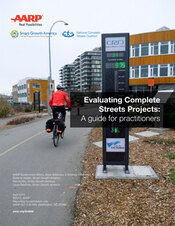
New Guide to Evaluate Complete Streets Projects
Complete Streets – streets designed and operated to enable safe access for all users, including pedestrians, bicyclists, motorists and transit riders – make communities more livable, multimodal, and safe. They have also been related to broader economic gains. A new guide recently published by Smart Growth America and the National Complete Streets Coalition, with support from AARP, provides guidance on how to measure Complete Street project performance to demonstrate successes and better understand what’s working and what’s not.
Evaluating Complete Streets Projects: A Guide for Practitioners is intended to assist transportation agencies and allied infrastructure and design professionals in beginning their project evaluation efforts. It outlines general steps, measures and metrics, tips for sharing successes, and further resources for communities ready to dive deeper into performance measurement. The measures are organized around common Complete Streets goals, such as access, safety, economic impact, the environment, public health, and quality of place.

Evaluating Complete Streets Projects is a supplementary guide to a report published last month, Safe Streets, Stronger Economies, which showcases 37 high-performing Complete Streets case studies from across the country.
The guide underscores the importance of pursuing measures most relevant to a particular community’s goals and that having clearly articulated goals for a project is essential to the project evaluation process.
Examples of Complete Streets metrics include:
- Driving trips as portion of total trips along project
- Portion of provided parking spaces for cars, bicycles used over course of day
- Retail and restaurant sales at businesses directly adjacent to project
- Temporary and permanent jobs created by project
- Percent of stormwater runoff absorbed through biofiltration
- Number of injurious or fatal crashes
- Number of people using the project space
Many of these metrics are similar to those found in the Landscape Performance Series Case Study Briefs, which showcase the environmental, economic, and social benefits of a wide variety of landscape projects. (Keep an eye out this spring for LAF’s own Guide to Evaluate Landscape Performance, which pulls together over 100 metrics in 34 benefit categories!)
Evaluating Complete Streets Projects: A Guide for Practitioners is an incredibly timely and useful resource for those embarking on performance evaluation. It will also serve to encourage the setting of performance objectives that better reflect multimodal needs and larger environmental, economic, and social goals. This is essential because – as the guide expresses so well – performance measures affect results since “what gets measured gets done.”
